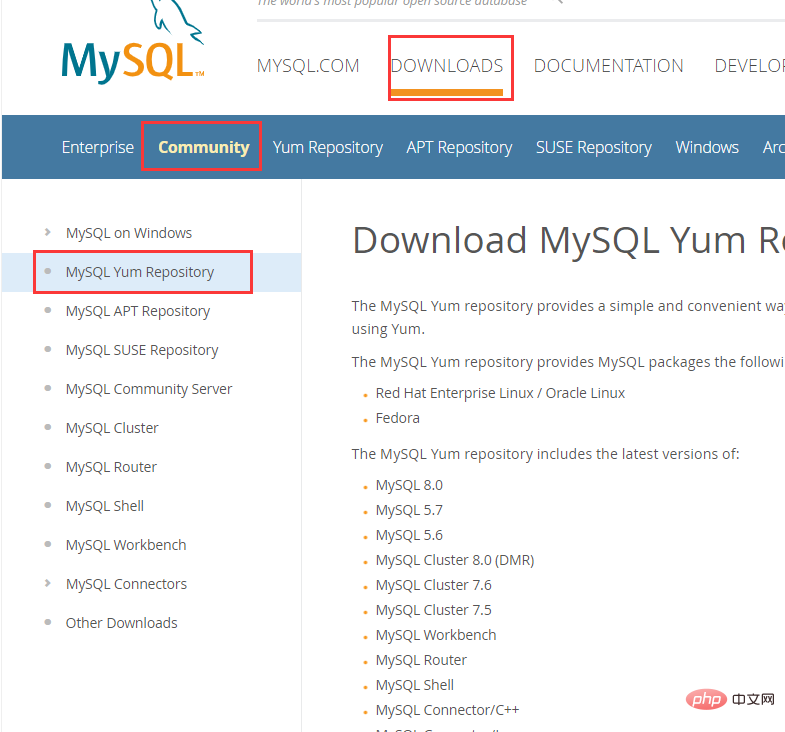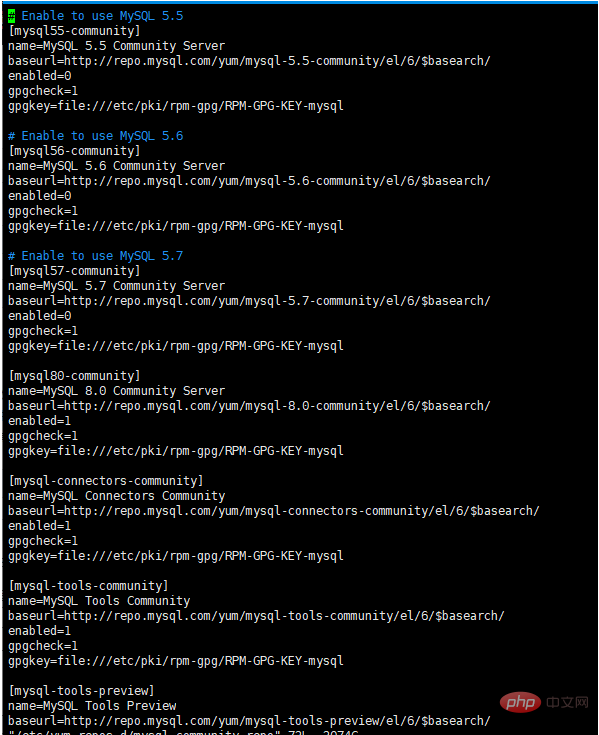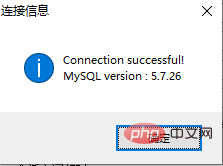How to install mysql on centos 6.5?

How to install mysql on centos 6.5:
1. Upload related packages (*.tar.gz, etc.)
Use relevant software to upload or use Xshell to connect and download the command: yum install lrzsz
2. Install mysql5.7
1. Check whether mysql is installed locally: rpm -qa | grep mysql
2. Uninstall the local mysql: yum remove mysql package
3. Download the installation package from the official website yum repository : wget http://dev.mysql.com/get/mysql80-community-release-el6-3.noarch.rpm
or download manually And upload it to linux

Then select

I am using CentOS6.5 here, all download this
4. Install the downloaded rpm package
yum localinstall mysql80-community-release-el6-3.noarch.rpm
5. Check the available installation packages
yum repolist enabled|grep mysql

6. Next, you need to change the mysql version
vim /etc/yum.repos.d/mysql-community.repo

For example, to install version 5.7, change the enabled=1 of the 80 source into enabled=0. Then change the enabled=0 of the 5.7 source to enabled=1.
7. Install mysql
yum install mysql-community-server -y
8. Start mysql and change related configurations
1>Start mysql: service mysqld start
2>Check whether mysql starts automatically, and set it to enable automatic startup
chkconfig --list | grep mysqld
chkconfig mysqld on
3>View initial password: grep "password" /var/log/mysqld.log

4>Log in to mysql: mysql -u root -p
5>Change password: SET PASSWORD FOR 'root'@'localhost' = PASSWORD('123456');
If the modified password is too simple, an error may be reported:
ERROR 1819 (HY000): Your password does not satisfy the current policy requirements
Execute the following statement:
set global validate_password_policy=0;
set global validate_password_length=4;
Execute the modify password statement again

6>Open root account remote access
grant all privileges on *.* to 'root'@'%' identified by '123456' with grant option;
7>Refresh permission table
FLUSH PRIVILEGES;
8>Modify the character set to UTF-8
linux: vim /etc/my.cnf
Add in the [mysqld] section:
port=3306
character-set-server=utf8
Add the [client] section at the end of the file and add in the [client] section:
port=3306
socket=/var/lib/mysql/mysql.sock
default-character-set=utf8
Add in the [mysql] section:
no-auto-rehash
default-character-set=utf8
After modification, restart the mysqld service:
service mysqld restart
(Import the sql script, first use the database, then source /home/sql/test.sql)
9>Use software to test remote connection to mysql

Recommended tutorial: "centos tutorial"
The above is the detailed content of How to install mysql on centos 6.5?. For more information, please follow other related articles on the PHP Chinese website!

Hot AI Tools

Undresser.AI Undress
AI-powered app for creating realistic nude photos

AI Clothes Remover
Online AI tool for removing clothes from photos.

Undress AI Tool
Undress images for free

Clothoff.io
AI clothes remover

Video Face Swap
Swap faces in any video effortlessly with our completely free AI face swap tool!

Hot Article

Hot Tools

Notepad++7.3.1
Easy-to-use and free code editor

SublimeText3 Chinese version
Chinese version, very easy to use

Zend Studio 13.0.1
Powerful PHP integrated development environment

Dreamweaver CS6
Visual web development tools

SublimeText3 Mac version
God-level code editing software (SublimeText3)

Hot Topics
 1657
1657
 14
14
 1415
1415
 52
52
 1309
1309
 25
25
 1257
1257
 29
29
 1229
1229
 24
24
 MySQL's Role: Databases in Web Applications
Apr 17, 2025 am 12:23 AM
MySQL's Role: Databases in Web Applications
Apr 17, 2025 am 12:23 AM
The main role of MySQL in web applications is to store and manage data. 1.MySQL efficiently processes user information, product catalogs, transaction records and other data. 2. Through SQL query, developers can extract information from the database to generate dynamic content. 3.MySQL works based on the client-server model to ensure acceptable query speed.
 How to start mysql by docker
Apr 15, 2025 pm 12:09 PM
How to start mysql by docker
Apr 15, 2025 pm 12:09 PM
The process of starting MySQL in Docker consists of the following steps: Pull the MySQL image to create and start the container, set the root user password, and map the port verification connection Create the database and the user grants all permissions to the database
 Laravel Introduction Example
Apr 18, 2025 pm 12:45 PM
Laravel Introduction Example
Apr 18, 2025 pm 12:45 PM
Laravel is a PHP framework for easy building of web applications. It provides a range of powerful features including: Installation: Install the Laravel CLI globally with Composer and create applications in the project directory. Routing: Define the relationship between the URL and the handler in routes/web.php. View: Create a view in resources/views to render the application's interface. Database Integration: Provides out-of-the-box integration with databases such as MySQL and uses migration to create and modify tables. Model and Controller: The model represents the database entity and the controller processes HTTP requests.
 Solve database connection problem: a practical case of using minii/db library
Apr 18, 2025 am 07:09 AM
Solve database connection problem: a practical case of using minii/db library
Apr 18, 2025 am 07:09 AM
I encountered a tricky problem when developing a small application: the need to quickly integrate a lightweight database operation library. After trying multiple libraries, I found that they either have too much functionality or are not very compatible. Eventually, I found minii/db, a simplified version based on Yii2 that solved my problem perfectly.
 Laravel framework installation method
Apr 18, 2025 pm 12:54 PM
Laravel framework installation method
Apr 18, 2025 pm 12:54 PM
Article summary: This article provides detailed step-by-step instructions to guide readers on how to easily install the Laravel framework. Laravel is a powerful PHP framework that speeds up the development process of web applications. This tutorial covers the installation process from system requirements to configuring databases and setting up routing. By following these steps, readers can quickly and efficiently lay a solid foundation for their Laravel project.
 MySQL vs. Other Programming Languages: A Comparison
Apr 19, 2025 am 12:22 AM
MySQL vs. Other Programming Languages: A Comparison
Apr 19, 2025 am 12:22 AM
Compared with other programming languages, MySQL is mainly used to store and manage data, while other languages such as Python, Java, and C are used for logical processing and application development. MySQL is known for its high performance, scalability and cross-platform support, suitable for data management needs, while other languages have advantages in their respective fields such as data analytics, enterprise applications, and system programming.
 MySQL and phpMyAdmin: Core Features and Functions
Apr 22, 2025 am 12:12 AM
MySQL and phpMyAdmin: Core Features and Functions
Apr 22, 2025 am 12:12 AM
MySQL and phpMyAdmin are powerful database management tools. 1) MySQL is used to create databases and tables, and to execute DML and SQL queries. 2) phpMyAdmin provides an intuitive interface for database management, table structure management, data operations and user permission management.
 MySQL vs. Other Databases: Comparing the Options
Apr 15, 2025 am 12:08 AM
MySQL vs. Other Databases: Comparing the Options
Apr 15, 2025 am 12:08 AM
MySQL is suitable for web applications and content management systems and is popular for its open source, high performance and ease of use. 1) Compared with PostgreSQL, MySQL performs better in simple queries and high concurrent read operations. 2) Compared with Oracle, MySQL is more popular among small and medium-sized enterprises because of its open source and low cost. 3) Compared with Microsoft SQL Server, MySQL is more suitable for cross-platform applications. 4) Unlike MongoDB, MySQL is more suitable for structured data and transaction processing.




